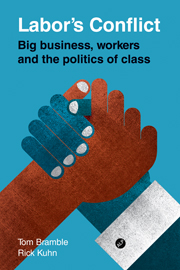Book contents
- Frontmatter
- Contents
- Preface
- Introduction
- 1 Labor's love's lost?
- 2 In the beginning: Labor's first quarter century
- 3 Between the Wars
- 4 Hot war, cold war, split
- 5 Labor after 70 years
- 6 The Whitlam era
- 7 Economic rationalism under Hawke and Keating
- 8 Labor in the wilderness
- 9 The Rudd–Gillard government
- 10 The Labor Party today: what's left
- Notes
- Index
3 - Between the Wars
Published online by Cambridge University Press: 10 January 2011
- Frontmatter
- Contents
- Preface
- Introduction
- 1 Labor's love's lost?
- 2 In the beginning: Labor's first quarter century
- 3 Between the Wars
- 4 Hot war, cold war, split
- 5 Labor after 70 years
- 6 The Whitlam era
- 7 Economic rationalism under Hawke and Keating
- 8 Labor in the wilderness
- 9 The Rudd–Gillard government
- 10 The Labor Party today: what's left
- Notes
- Index
Summary
Having seen off threats from the right and left, the ALP recovered quite quickly from the split of 1917. Although Labor did not hold federal office between 1916 and 1929, the Party won every election in Queensland from 1915 until 1929, and formed governments in several other states.
Labor's recovery in New South Wales was particularly important. The defeat of the general strike was a setback for the unions but its effects were only temporary; the process of radicalisation that began in 1915 continued apace. Although repression, initiated by ALP governments, had destroyed the IWW, the syndicalist idea that the key to effective working class organisation was one big union attracted widespread support among rank and file unionists and left wing union officials. Industrial militancy soared after the war: workers in Australia struck for a total of 8 million days in 1919–20, one-quarter more than in the previous peak of 1916–17.
Working class radicalisation and industrial militancy pushed the ALP further to the left. In 1919, militant unions, led by the Miners Federation, set up the Industrial Socialist Labour Party and succeeded in getting Percy Brookfield elected as the MLA for Broken Hill. Under pressure from below, the federal Labor Party adopted ‘the socialisation of industry, production, distribution and exchange’ as an objective in 1921. The ALP was now formally committed to socialism, albeit only as a distant goal – it was not included in the Fighting Platform on which Labor contested elections.
- Type
- Chapter
- Information
- Labor's ConflictBig Business, Workers and the Politics of Class, pp. 43 - 54Publisher: Cambridge University PressPrint publication year: 2010

